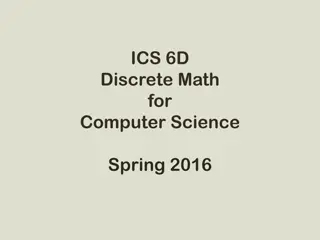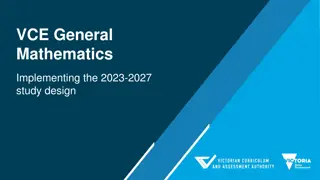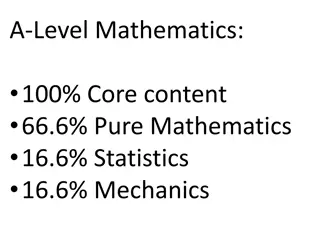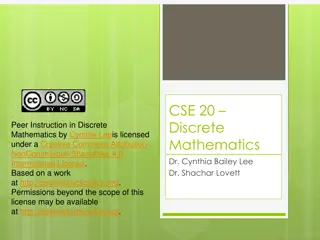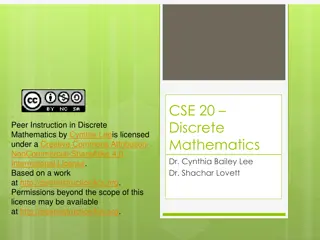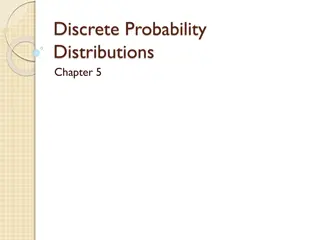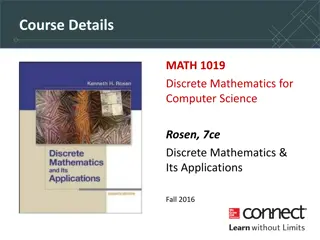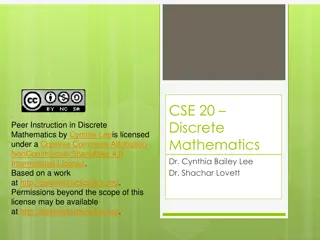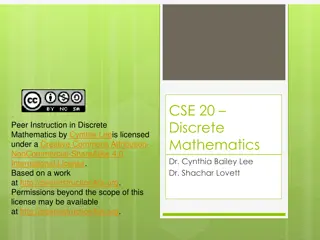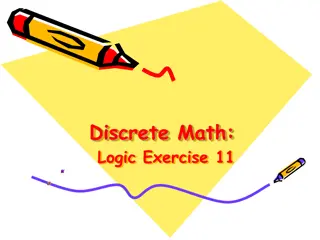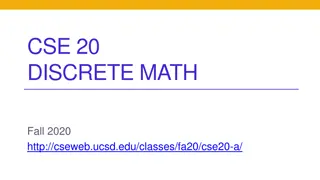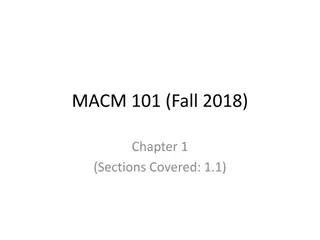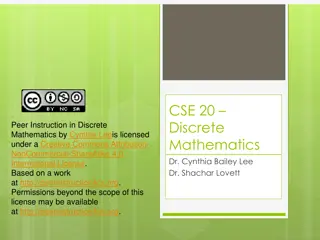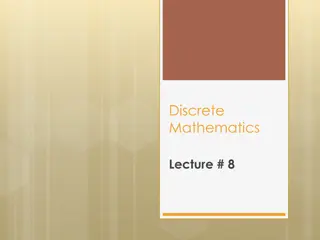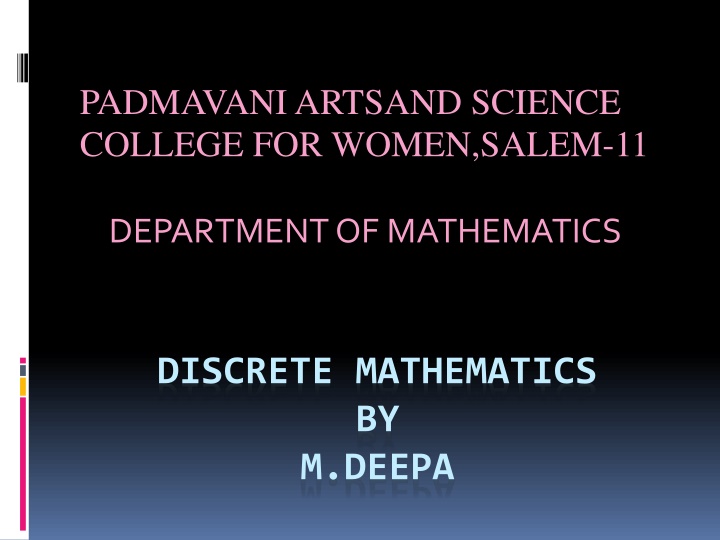
Discrete Mathematics: Validity, Inference Rules, Consistency, and Set Theory
Explore the foundational concepts of discrete mathematics, including theory of inference, rules of inference, consistency of premises, statement functions, variables, quantifiers, free and bound variables, set theory, functions, and composition of functions. Delve into the logical reasoning behind statements and the relationships between sets through detailed explanations and examples.
Download Presentation

Please find below an Image/Link to download the presentation.
The content on the website is provided AS IS for your information and personal use only. It may not be sold, licensed, or shared on other websites without obtaining consent from the author. If you encounter any issues during the download, it is possible that the publisher has removed the file from their server.
You are allowed to download the files provided on this website for personal or commercial use, subject to the condition that they are used lawfully. All files are the property of their respective owners.
The content on the website is provided AS IS for your information and personal use only. It may not be sold, licensed, or shared on other websites without obtaining consent from the author.
E N D
Presentation Transcript
PADMAVANI ARTSAND SCIENCE COLLEGE FOR WOMEN,SALEM-11 DEPARTMENT OF MATHEMATICS DISCRETE MATHEMATICS BY M.DEEPA
UNIT-I THEORY OF INFERENCE VALIDITY USING TRUTH TABLES: Let A and B be two statement formulas. We say that, B logically follows from A or B is a valid conclusion (consequence) of the premise A iffA B is a tautology, that is , A B.
RULES OF INFERENCE Two rules of inference which are called rules P and T. Rule P: A premise may be introduced at any point in the derivation. Rule T: A formula S may be introduced in a derivation if S is tautologically implied by any one or more of the preceedingformulas in the derivation.
CONSISTENCY OF PREMISES CONSISTENT: A set of formulas H1,H2, .Hmis said to be consistent if their conjunction has the truth value T. A set of formulas H1,H2, .Hmis said to be inconsistent if their conjunction has the truth value F.
THE STATEMENT FUNCTION, VARIABLES AND QUANTIFIERS A simple statement function of one variable is defined to be an expression consisting of a predicate symbol and an individual variable. The resulting from a replacement is called a substitution instance of the statement function and is a formula of statement calculus.
FREE AND BOUND VARIABLES Given a formula containing a part of the form (x) P(x) or( x) P(x),such a part is called an x-bound part of the formula. Any occurrence of x is an x-bound part of the formula is called a bound occurrence of x, while any occurrence of x or of any variable that is not a bound occurrence is called free occurrence.
UNIT-II SET THEORY FUNCTIONS: Let X and Y be any two sets. A relation f from X to Y is called a function if for every x X there is a unique y Y such that (x, y) f.
COMPOSITION OF FUNCTIONS Let f:X Y and g:Y Z be two functions. The composite relation g f such that g f = { <x, z> | (x X) ( z Z) ( y) (y Y y = f(x) z = g (y))} is called the composition of functions or relative product of functions f and g. More precisely, g f is called the left composition of g with f.
INVERSE FUNCTIONS It is easy to see that for a given f:X X, f is a function only if f is one to one. But this condition does not guarantee that f is a function from Y to X. A mapping Ix:X X is called an identity map if Ix ={<x, x>| x X}.
BINARY AND n-ARY OPERATIONS Let X be a set and f be a mapping f: X xX X. Then f is called a binary operation of X. In general, a mapping f: Xn X is called an n-ary operation and n is called the order of the operation. For n=1, f:X X is called a unary operation.
CARDINALITY Two sets A and B are said to be equipotent and written as A~B if and only if there is one to one correspondence between the elements of A and those of B. Note that one to one correspondence can be established by showing a mapping f: A B which is one to one and onto.
UNIT-III ALGEBRAIC STRUCTURES KERNAL OF HOMOMORPHISM: Let g be a group homomorphism from <G, *> to <H, >. The set of elements of G which are mapping to eH, the identity of H, is called the kernel of homomorphism g and denoted by ker (g).
COSETS AND LAGRANGES THEOREM Let <H, *> be a subgroup of <G,*>. For any a G, the set aH defined by aH ={ a*h |h H} Is called the left cosetsof H in G determined by the element a G. The element a is called the representative element of the left coset aH.
NORMAL SUBGROUP DEFINITION: A subgroup <H, *> of <G, *> is called a normal subgroup if for any a G, aH = Ha. EXAMPLE Determine all the proper subgroups of the symmetric group <S3, > as described.
ALGEBRAIC SYSTEM WITH TWO BINARY OPERATIONS DEFINITION: An algebraic system <S, +,.> is called a ring if the binary operation + and . On S satisfies following three properties: 1. <S,+> is an abelian group. 2. <S, .> is an semi group. 3. The operation . Is distributive over +; that is, for any a , b, c S, 4. a.(b+c)=a.b+a.c 5. (b+c).a= b.a+c.a
UNIT-IV LATTICES AND BOOLEAN ALGEBRA LATTICES AND ALGEBRAIC SYSTEM: A lattice is an algebraic system <L,*,+> with two binary operation * and + on L which are both (1) commutative (2) associative and (3) satisfies the absorption laws.
SUBLATTICES, DIRECT PRODUCT AND HOMOMORPHISM Let <P, > and <Q, > be two partially ordered set. A mapping f : P Q is said to be order preserving relative to the ordering in P and in Q if and only if for any a, b belongs to P such that a b, f(a) f(b) in Q . If <P, > and <Q, > are lattices and g : P Q is a lattice homomorphism, then g is the order preserving.
BOOLEAN FORMS AND FREE BOOLEAN ALGEBRA DEFINITION : Two Boolean forms (x1, x2, xn) and (x1, x2 , ..xn) are called equivalent if one can be obtained from the other by a finite number of applications of the identities of a Boolean algebra.
UNIT-v GRAPH THEORY BASIC DEFINITIONS: A graph G= <V, E, > consists of non empty set V called the set of nodes of the graph E is said to be set of edges of the graph, and is a mapping from the set of edges E to be a ordered or unordered pairs of elements of V.
PATHS, REACHABILITY AND CONNECTEDNESS 1. The number of edges appearing in the sequence of a path is called the length of the path . 2. A paths in a digraph in which the edges are all distinct is called a simple path. A path is which all the nodes through which is traverese are distinct is called an elementary path.

